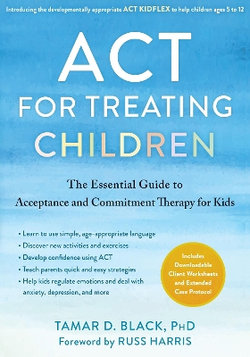Steven Hayes:
“A beautifully written and comprehensive book that addresses every aspect of the use of ACT methods with children. In addition to putting forth a treasure trove of new materials and new ideas, I love how it builds out classic ACT methods in ways that are thoroughly age appropriate and yet recognizable, so that practitioners can follow Tamar's lead and begin to apply other things they may know about ACT in creative new ways as well. A transformational book that every practitioner who works with children should have at arm's reach.”
Steven C. Hayes, PhD, Nevada Foundation Professor in the department of psychology at the University of Nevada, Reno, and originator of ACT.
Kirk Strosahl:
“Tamar Black wrote ACT for Treating Children to be the book she wished was available when she first started using ACT with children. She has created a book that is an absolute must, not just for clinicians new to ACT, but also experienced ACT therapists. This book is highly informative, full of clinical tips and practical advice, and is an interesting read from start to finish. Highly recommended!”
Kirk Strosahl PhD, Co-founder of Acceptance and Commitment Therapy. Author, The Mindfulness and Acceptance Workbook for Depression: Using Acceptance and Commitment Therapy to Move Through Depression and Live a Vital Life, 2nd Edition.
Paul Gilbert:
“In this fascinating and important book Tamar Black guides practitioners through how to help children gain insight into their minds and cultivate competencies that can promote well-being. Especially helpful are its extensive and clear descriptions of experiential work. Even if you are not an ACT therapist the wealth of ideas is clearly written, easily understood and of immense value. Anyone working with children will gain enormously from this book.”
Professor Paul Gilbert, OBE, founder of Compassion Focused Therapy and bestselling author of The Compassionate Mind.
Russell Kolts:
"ACT for Treating Children is a clear, thorough, and deeply pragmatic guide for applying acceptance and commitment therapy with children. The book contains a wealth of clinical experience, getting into the nuances of how to utilize ACT with children in a way that anticipates and answers common questions that clinicians are likely to have! An excellent resource for all therapists who work with children."
Russell Kolts, Professor of Psychology, Eastern Washington University, and author of CFT Made Simple and The Compassionate Mind Guide to Managing Your Anger.
Matthew D. Skinta:
“What a wonderful book!!! As an experienced supervisor and trainer of ACT, I was deeply impressed by how adeptly Tamar has keyed in to frequent points of confusion and misunderstanding. This book is both a phenomenal introduction to ACT and its therapeutic stance, as well as the book I always wish I had to share with child psychologists in training. The clear guidance on conceptualization and child appropriate questions for assessment are bright spots throughout.”
Matthew D. Skinta, PhD, ABPP, assistant professor of psychology at Roosevelt University and author of Contextual Behavior Therapy for Sexual and Gender Minority Clients.
Amy R. Murrell:
“This book has great practical application, with easy-to-understand descriptions of developmentally appropriate case conceptualization, technique, and stance. There are wonderful examples, including a helpful section on working with parents. The accompanying worksheets help concretize metaphor and experiential exercises, which is essential for this age group. This protocol-like book will be very useful for individuals new to ACT or new to ACT with youth. I highly recommend it!”
Amy R. Murrell PhD, licensed psychologist, Peer-Reviewed ACT Trainer, ACBS Fellow, author of the Becca Epps series and co-author of The Joy of Parenting.
Christopher McCurry:
“This is a wonderfully practical book, from the delightful “Kidflex” to worksheets to important suggestions that will make anyone a better therapist with any client. This book will be a lifesaver for people wading into doing ACT with kids. It is truly an essential guide for anyone wishing to bring ACT to their work with children, and for seasoned ACT clinicians who want to hone their craft.”
Christopher McCurry, PhD, author of Parenting Your Anxious Child with Mindfulness and Acceptance and co-author of The Mindfulness and Acceptance Workbook for Teen Anxiety.
Janina Scarlet:
"A long overdue and much needed book, ACT For Treating Children provides a step-by-step Kidflex model for teaching the heart of acceptance and commitment therapy to children in an approachable, compassionate, and very helpful way. If you work with children, you need this wonderful book."
Janina Scarlet, PhD, award-winning author of Superhero Therapy.
Emily K. Sandoz:
“In ACT for Treating Children, Dr. Black provides a refreshing adaptation of Acceptance and Commitment Therapy to the complex work of psychotherapy with kids. Dr. Black brings substantial clinical experience to bear in accessible theoretical adaptations to the psychological flexibility model, immediately actionable technologies, and easy-to-follow guidelines for the therapist’s stance – all with well-contextualized examples. Reading this book will benefit any child therapist interested in doing transformative work with children.”
Emily K. Sandoz, PhD, professor of psychology at University of Louisiana at Lafayette, co-author of The Mindfulness and Acceptance Workbook for Bulimia: A Guide to Breaking Free from Bulimia Using Acceptance and Commitment Therapy.
Michael P. Twohig:
“Written by an expert on ACT, Dr. Black provides an all-inclusive guide on how to implement ACT with children. This book fills a void in the ACT literature. Reading this book greatly expanded my ACT repertoire, and it will do the same for you.”
Michael P. Twohig, PhD, Professor at Utah State University, co-author of ACT in Steps.
Christopher Willard:
"At last, not just a guide to ACT for children, but a comprehensive, straightforward, and fun one at that!"
Christopher Willard, PsyD, Faculty at Harvard Medical School, author of Growing Up Mindful.




Share This Book: